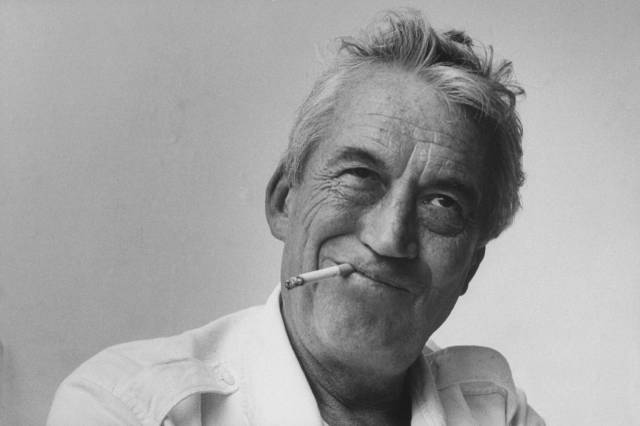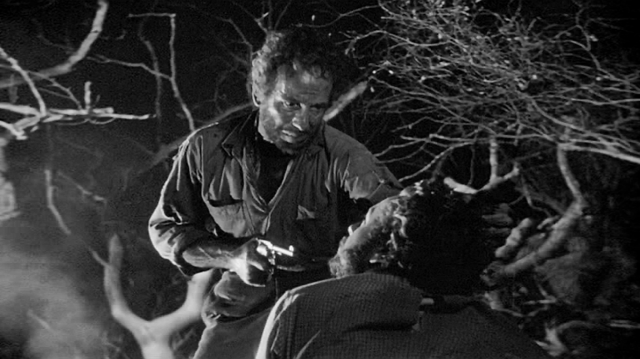
 John Huston left behind a body of work so imprinted with his style and sensibility that it is often hard to understand why critics like Andrew Sarris didn’t hail him as an auteur. It is arguable that John Huston has one of—if not the—greatest debut film in cinema history, The Maltese Falcon (1941). While it was technically the third adaptation of Dashiell Hammett’s novel of the same name, The Maltese Falcon was the film that would define one the most important eras of American cinema, the “Classical Film Noir.” From his debut, Huston would go on to direct and write over forty films, and act in over fifty more. Stylistically speaking, Huston was eclectic almost to a fault—and perhaps why he was never donned as an auteur—, producing detective, horror, sci-fi, musicals, westerns, comedy, and more. Yet, despite the range of stylistic tendencies, shaped through decades in the industry, Huston’s films always maintained thematic consistencies. Of those tendencies, an engagement between the boundaries of faith and doubt is prevalent, highlighted by The Film Society of Lincoln Center’s new Huston retrospective: Let There Be Light. With over forty films to choose from, narrowing down a reasonable amount of films to see in this retrospective can be no easy task. In order to help inform your decision, here is a snapshot of films being screened that define Huston’s oeuvre.
John Huston left behind a body of work so imprinted with his style and sensibility that it is often hard to understand why critics like Andrew Sarris didn’t hail him as an auteur. It is arguable that John Huston has one of—if not the—greatest debut film in cinema history, The Maltese Falcon (1941). While it was technically the third adaptation of Dashiell Hammett’s novel of the same name, The Maltese Falcon was the film that would define one the most important eras of American cinema, the “Classical Film Noir.” From his debut, Huston would go on to direct and write over forty films, and act in over fifty more. Stylistically speaking, Huston was eclectic almost to a fault—and perhaps why he was never donned as an auteur—, producing detective, horror, sci-fi, musicals, westerns, comedy, and more. Yet, despite the range of stylistic tendencies, shaped through decades in the industry, Huston’s films always maintained thematic consistencies. Of those tendencies, an engagement between the boundaries of faith and doubt is prevalent, highlighted by The Film Society of Lincoln Center’s new Huston retrospective: Let There Be Light. With over forty films to choose from, narrowing down a reasonable amount of films to see in this retrospective can be no easy task. In order to help inform your decision, here is a snapshot of films being screened that define Huston’s oeuvre.
No list of Huston’s films could be complete without the inclusion of The Maltese Falcon. Only the second starring role for the already 42-year-old actor Humphrey Bogart, The Maltese Falcon is the film that helped to solidify Bogie's talents and make him a star. To say that the film is an impressive directorial debut is a gross understatement. Painting the film with an expressionistic palette, Huston, along with Universal Horror veteran cinematographer Arthur Edeson, created the template that would define an era. Largely hailed as the first film noir, The Maltese Falcon is one of the most important films ever made.
Following the release of his third film, Across the Pacific, Huston was activated by the US Army to make films during the War. For the next four years, Huston would produce four documentaries. Of these, Let There Be Light is perhaps the most important. The film, which analyzes soldiers suffering from PTSD, was considered highly controversial upon its production. This led to the film being banned for release by the Army, delaying its ultimate release until the 1980s. Thanks to FilmLinc, New Yorkers get the rare chance to attend a screening of Huston’s most important film in his short stint as a documentary filmmaker.
 The Treasure of the Sierra Madre (1948)
The Treasure of the Sierra Madre (1948)
While he was nominated for 15 Academy Awards over his forty-year career, Huston would only be awarded two, both for his efforts (as writer and director) on The Treasure of Sierra Madre. The Treasure of Sierra Madre is adventure story that pushes its characters to the brim. For its characters, greed serves as both motivation as well as destruction. It rips the bleak outlook from the wet streets of gangster pictures and displaces it to mountains of Mexico. Regardless of whether you’ve seen The Treasure of Sierra Madre or not, you’ve undeniably seem remnants of the film, as it has become the blueprint for countless films since its release. The Treasure of Sierra Madre is not an emblem of American cinema, it is American cinema.
Released nine years after The Maltese Falcon, The Asphalt Jungle signifies the changing narrative and aesthetic interest in late-noir/early neo-noir period. As post-war disillusionment turns into Cold War hysteria, American cinema changed from grim to outright pessimistic. Huston’s film stands as one of the earliest and best exemplars of the “heist” film, a subgenre that become increasingly popular during the 1950s. With The Asphalt Jungle, Huston pushes the noir aesthetic to the max. A veneer of filth and grime cover all of the film's surfaces, it is Huston at his darkest and dirtiest. While it has accumulated a steady audience, The Asphalt Jungle is still one of Huston's most underrated films.
The second to last time that Bogart and Huston would work together, The African Queen is the only film that would win Bogart an Oscar. Paired with the energetic and captivating Katharine Hepburn the acting team is the epitome of charm. Hepburn’s quick talking energy and prowess for slapstick serves to contrast the hardened yet smooth Bogart. The African Queen is a film for actors; it is emblem of all of the aspects that make actors stars. It takes the adventure elements of The Treasure of Sierra Madre and strips away the gloom. What is left is in its place is one part melodrama, one part comedy, and one part adventure, an equation that equals pure entertainment. The highest ranked Huston film on AFI’s top 100, African Queen may be Huston’s most widely viewed and enjoyed film.
While the two only worked together twice, Huston had the strange task of both welcoming Marilyn Monroe to film (with The Asphalt Jungle), as well as, casting her in what would be her last major performance with The Misfits. Other than featuring Monroe’s final performance, the film is famous for also featuring Clark Gable’s last performance. The sole collaborative effort between Huston and playwright Arthur Miller, this revisionist western was a return to form for Huston. The beauty of The Misfits lies in how the film deconstructs mythologized American images of the West; the death knell to one of Hollywood's most beloved genres.
While Huston’s talents behind the camera are inarguable, it would be an error to deny his abilities as an actor. Aside from being one of neo-noir’s most important films, and one that remains challenging and invigorating to this day, Chinatown presents one of Huston’s finest performances. Co-Starring as water tycoon Noah Cross, Huston’s self-reflexive performance resonates from the screen with a rare power. Huston, as Cross, has a frightening charisma: you love him, you hate him, and you love to hate him. Huston commits to the performance and with it delivers one of cinema's greatest villains.
There isn’t another film in the series that better exemplifies the struggle between faith and doubt better than Wise Blood. Casting character actors, it is a film not only about faith and doubt but also about performance. A faithful but non-identical adaptation of Flannery O’Connor’s debut novel, Huston ingeniously added a layer of dark comedy to the plot. Wise Blood is one of Huston’s most challenging films, one that personifies his career, and one that heavily marks his later era output.
Without a doubt, the 1980’s sci-fi horror hybrid Phobia is one of Huston’s least acclaimed films and most singular works. Phobia is the black sheep of Huston's filmography, the one that bears the least semblance of Huston's mark. Simply said, there is nothing else quite like it in all of his filmography. While it is important in these retrospectives to view the iconic work by a filmmaker, sometimes it is equally fruitful to engage with some of the lesser works. It may be Huston at his "worst", but as his only foray into "pure" genre cinema, Phobia is an interesting case study in finding the elements of Huston's style that are still able to shine through.
In choosing the perfect bookend for the Huston retrospective, the choice falls between Prizzi’s Honor and Huston’s swan song, The Dead. While entirely different efforts, both films highlight the impressive directorial prowess that Huston maintained well into his 70s. While choosing between them can be tough, the deciding factor lies with the Anjelica Huston’s Q+A session attached to Prizzi’s Honor. After all it is not everyday you get that chance to see Anjelica Huston speak about working with her father live and in-person.